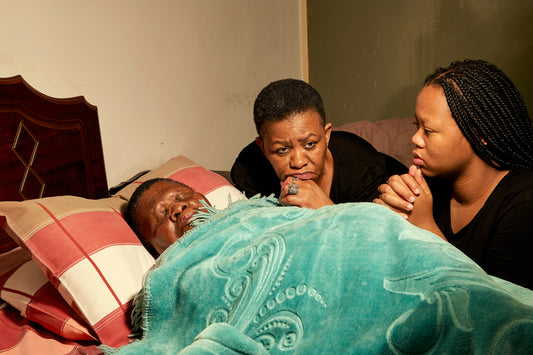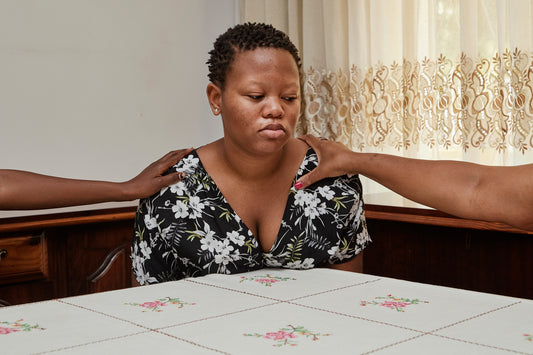Oeuvre Projects x Lemkus Gallery are honoured to present Thero Makepe’s new solo exhibition, titled We Didn’t Choose to be Born Here. We Didn’t Choose to be Born Here, curated by Jared Leite, runs from 15 February - 12 April 2025 at the Lemkus Gallery, in Cape Town, South Africa, marking the first presentation of a critically acclaimed body of work on African soil. Makepe is a visual artist specialising in photography from Gaborone, Botswana. The exceptional quality of his work and his commitment to storytelling has garnered the support of prominent institutions and individuals, such as Prince Claus, Diane and Charles Frankel and the British Council, as well as exhibition partnerships with Vela Projects and Latitudes Online. The impetus for this exhibition, Makepe’s deserved reception of the Prince Claus SEED Award in 2024, is such an occasion— a call to celebrate his journey and to share his work with the local community. To this end, We Didn’t Choose to be Born Here could be thought of as an anthology of key moments in his career, a show of greatest hits and newly-produced works.
Born amidst the paradigmatic shift in the region, the transition from apartheid to a newly democratic South Africa, Thero Makepe comes into being as an individual shaped by the realities of two distinct yet powerfully interconnected societies. Appropriately, his work explores this complex transnational history and visualises its multiple manifestations through ongoing social and political residuum. Moreover, it is a practice spurred on by the rich legacy of his family, the great sacrifices and successes of his ancestors and their role in sowing seeds of revolution that continue to bear fruit. Take for instance the resounding familial echo of Thero’s late uncle Zephania Mothopeng, famously dubbed ‘The Lion of Azania’, who founded the Pan-Africanist Congress (PAC) and faced imprisonment in Robben Island alongside Nelson Mandela. Figures such as Zephania Mothopeng, among several others, become the constituent voices in the shared consciousness of Makepe’s work and ground his photographic narratives.
A different but equally relevant aspect of the legacy of resistance imbued in Makepe’s family heritage is that of music, namely jazz, indexed by ancestors Hippolytus Mothopheng (grandfather) and the iconic John Mothopeng— whose sonic offerings underscored the anti-colonialist atmosphere at the height of the struggle against apartheid. Thero’s undergraduate project, Music from My Good Eye (2019) was an ode to the history of musicality and activism in his family that sought to collate fragments of their many accomplishments. What this body of work demonstrated was Makepe’s gift, not as an orator or performer, but as a custodian of memory with the ability to engage in deeply personal intergenerational conversations and with the generosity to share these stories with the wider world through the medium of photography.
Yet unlike his predecessors, whose contributions could be characterised by a sense of revolutionary urgency and uproar, Makepe’s photographic lens has different aesthetic qualities and conceptual capacities. Though there is an ostensible air of critique, what distinguishes Makepe’s photographs is their incredible stillness and perceptive depth: his ability to distill weighty subjects and emotionally laden moments within a single frame. Salient themes of grief and longing connect with instances of familial rupture, the effects of forced and self-imposed exile and state capture/imprisonment. Makepe retells lesser-known histories of violence, such as the South African Defense Force’s massacre of anti-apartheid activists through its breach of Botswana’s sovereign borders, condensed in an unsuspecting shot of dilapidated buildings at the scene of the crime. In this way, fugitivity as a concept is deployed by Makepe both as an acute aspect of his family past and as a broader consequential condition of colonial violence.
Central to his aim and purpose as a storyteller is the practice of bookmaking, a process that reveals his nuanced artistic sensibilities. This practice, requiring the sensitive arrangement of disparate fragments into a cohesive whole, extends to the curatorial framing of We Didn’t Choose to Be Born Here, in which images and archive material structure a chronology of experiences as precursors for artistic production. More on the subject of Makepe's process, it is important to note that family members are incorporated not just as passive subjects, but as active agents in the reperformance of memory and the handling of suffering. Collectively, Makepe and his troupe of actors capture contrasting yet contemporaneous phenomena; faith and resilience under catastrophic circumstances, nationalism and belonging, land, systemic anti-blackness, social dread, and hope in the face of shifting political dimensions. In accordance with the breadth and shared significance of Makepe’s work, We Didn’t Choose to Be Born Here welcomes viewers and family alike to experience the incredible latitude of his lens in physical space and to appreciate its simultaneous bearing on past and present. Through its sensitive reflection on the tension between resistance and the state of civil society in present day, Makepe’s affirms the sacrifices and costs of the fight for freedom, and warns of continued toll hegemony.













